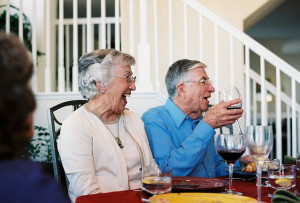It has been well documented that mood is affected in part by the endocannaboid system in both animals and humans. Specifically, levels of various endocannaboids (ECs) and their receptors have been directly implicated in mental health conditions such as anxiety and depression, with decreased levels of certain ECs found in patients suffering from these ailments. It’s thought that the EC system might act as a sort of buffer in healthy individuals that help depress negative emotions and elevate mood, which has been confirmed in studies using neuroimaging techniques.

Photo by Flickr user South African Tourism
EC levels have been shown to change depending upon stress stimuli in animals and humans. For example, studies have shown that certain ECs increase in concentration in response to psychological stressors, indicating that ECs may be responsible (at least in part) in regulating mood and stress response in humans.
Taking what is known about mood changes and their effects on circulating levels of various ECs in the body, a group of Dutch researchers aimed to evaluate whether mood changes influenced by ambience and alcohol consumption during a meal had any effects on circulating EC levels in the blood of study subject, since it has been shown that both ambiance and alcohol consumption influences mood in humans. Published recently in the journal PLoS ONE, the researchers attempted for the first time ever to evaluate changes in mood caused by ambiance and alcohol consumption on circulating ECs with the hypotheses that a bad mood would result in increased EC levels and a good mood would result in decreased EC levels in humans.
Brief Methods
28 healthy Dutch women between the ages of 18 and 45 participated in this study. According to the researchers, only 24 were needed to achieve statistical significance in the results (if there would be any to find). Participants were not on any medication other than birth control, nor were they users of any recreational drugs. Participants were regular alcohol drinkers (consuming between 3 and 20 glasses per week) and had no family history of alcoholism.
Utilizing a randomized, single-blind, crossover study design, participants were asked to consume three glasses of white sparkling wine and three glasses of alcohol-free white sparkling wine with a meal under pleasant or unpleasant ambiance (though not all at once). Every participant experiences each of the 4 scenarios at one time during the study, with one scenario occurring each week.
Participants were not told exactly what the study was trying to determine, though they were told that the goal was to examine the effects of different meal settings on various hormones in the blood. They were also told that the alcohol levels would vary throughout the study, but they didn’t say by how much (or that some were completely non-alcoholic).
On study days, blood was drawn before the meal started as a baseline measurement. Participants were then kept for at least 15 minutes in a relaxed setting with soft music prior to starting the meal. After this short period of time, participants were taken to rooms with either pleasant or unpleasant ambiance (described below).
During this time, participants filled our surveys asking questions related to mood. After the survey, participants were asked to consume one glass of either alcoholic or non-alcoholic white sparkling wine within 5 minutes time. Immediately after consuming the first glass, participants were served a macaroni dish with 2 more glasses of the same wine as the first. Both the meal and the two glasses of wine had to be consumed within 15 minutes.
Blood draws occurred before the first drink, and then after 30 and 120 minutes after consuming the meal and beverages. Blood alcohol content was measured using a breathalyzer, and the mood surveys were completed before the first drink and again at 20, 50, and 110 minutes after consuming the meal and beverages.
The pleasant room ambiance experience was set up as follows: colorful décor, soft lighting, and soft music. Participants were also shown a 2.5 minute clip of a happy scene from Bambi and The Lion King (the “Bambi on Ice” scene and the “Hakuna Matata” scene). Scenes were shown during the consumption of the first glass of wine.
The unpleasant room ambiance experience was set up as follows: very bright lighting, no music, filled dustbin adjacent to the table, no décor, and plastic serving dishes and utensils. Participants were also shown a 2.5 minute clip of a sad scene from Bambi and The Lion King (the “Bambi’s mother dying” scene and the “Lion King’s father dying” scene). Scenes were shown during the consumption of the first glass of wine. Each scene was only watched once.
Key to Abbreviations of Specific ECs listed in Results Below:
AEA: Anandamide
NAE: N-acylethanolamine
SEA: Stearoylethanolamide
OEA: Oleoylethanolamide
DHEA: Docosahexaenoylethanolamide
PEA: Palmitoylethanolamide
2-AG: 2-arachidonoylglycerol
Selected Results
- Tension scores were higher in unpleasant ambiance than pleasant ambiance.
- Depression scores continued to increase in unpleasant ambiance until 110 minutes after starting the experiment.
- Calmness scores were lower after consuming alcohol compared with after consuming alcohol-free wine.
- Happiness scores were higher 20 and 50 minutes after consuming alcohol.
- Happiness scores were higher in unpleasant ambiance with alcohol than the unpleasant ambiance without alcohol.
- Happiness scores did not change in the pleasant ambiance with or without alcohol.
- All of the above were statistically significant.
EC Level Changes (all results mentioned in this section were statistically significant)
- OEA and DHEA increased 30 minutes after eating.
- AEA, OEA, and PEA decreased 120 minutes after eating.
- 2-AG levels were not altered after eating.
- PEA and SEA levels increased in pleasant ambiance and decreased in unpleasant ambiance 30 minutes after eating.
- 2AG, AEA, and NAE were not influence by ambiance or alcohol consumption.
- Happiness scores were negatively correlated with 2-AG and PEA levels (i.e. as happiness increased, 2-AG and PEA levels decreased).
- Fatigue scores were positively correlated with AEA and DHEA levels (i.e. as fatigue increased, AEA and DHEA levels increased).
- Vigor scores were negatively correlated with OEA levels (i.e. as vigor increased, OEA levels decreased).
- Calmness scores were positively correlated with SEA levels (i.e. as calmness increased, SEA levels increased).
- No EC level changes correlated significantly with fatty acid level changes.
- 2-AG and AEA levels were positively correlated with cortisol levels in all scenarios, except for the unpleasant ambiance with alcohol.
- OEA and DHEA were positively correlated with cortisol levels in the unpleasant ambiance with alcohol scenario.
- SEA levels were negatively correlated with cortisol levels in the unpleasant ambiance with alcohol scenario.
- Cortisol levels were decreased 120 minutes after alcohol consumption compared with non-alcoholic consumption.
Conclusions
Overall, the results of this study showed for the first time that the endocannaboid system is influenced by ambiance during and after a meal. The specific ECs PEA and SEA were found to increase in an unpleasant ambiance which correlated strongly with tension and depression scores. In other words, the unpleasant environment stressed the participants out, which resulted in a physiological response by the endocannaboid system. (Seriously though, who wouldn’t be stressed out by watching Bambi’s mother die).
When alcohol was introduced, there were significant interactions between the alcohol consumption and the ambiance of the room during the meal. Specifically, consuming alcohol basically made the unpleasant environment a little more tolerable, as noted in the increase in happiness score by those consuming alcohol in the unpleasant environment compared with those drinking the alcohol-free wine in the same environment. Interestingly, consuming the wine in the pleasant environment did not improve happiness any more than it already was after consuming the non-alcoholic wine in the same environment. The results then would seem to suggest that alcohol makes a crappy environment better, while it won’t make you any happier than you would have been already in the nice environment.

Photo by Flickr user Katina Rogers
Of course, drinking alcohol did not make the unpleasant environment turn pleasant in terms of the stress response, but moderate consumption still managed to help a little bit. (Note: please don’t go drinking your sorrows away thinking that it’ll make it all better. It won’t.).
For the most part, this study somewhat confirms what we already had probably guessed based on our own experiences: wine makes you happy and makes a bad situation not seem so bad. What is new and interesting, however, are the results that showed that the endocannaboid system plays a seemingly significant role in regulating these moods, and that various stressors and the influence of alcohol alters the levels of various ECs in this system, resulting in the physiological responses that we can all see on the outside.
While this study is the first of its kind to show these results, it is important to realize that they may not be generalizable to the entire population. First, this study was performed using just women. It is well documented that women and men respond differently to various stressors, so the responses seen in this study by women may be different for me. Only another experiment utilizing men would clear that up.
Results from this study provide further evidence of the role of the endocannaboid system in mood regulation, and show for the first time how ambiance during a meal and alcohol consumption affects this system. This is fascinating from a purely scientific standpoint and for possible clinical applications as well.
Source:
